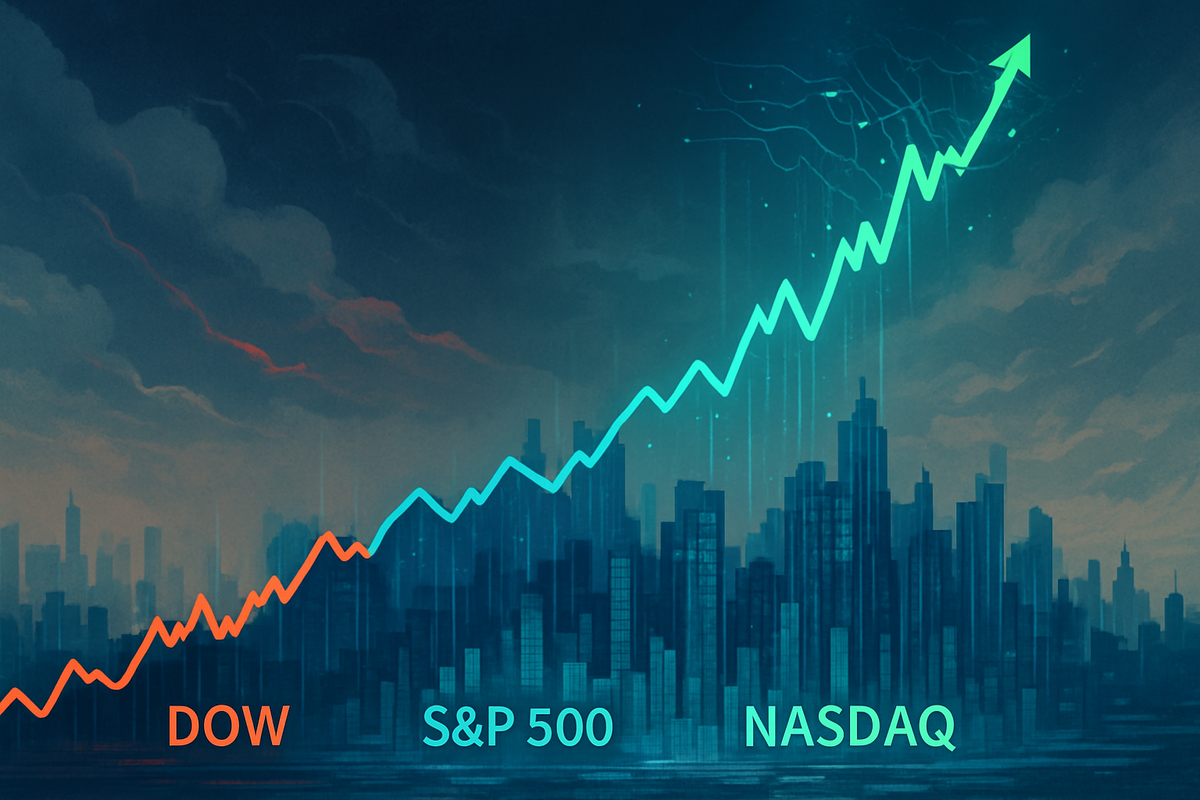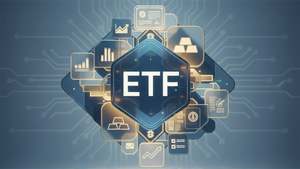
As of October 16, 2025, the U.S. stock market is a tapestry woven with threads of robust corporate earnings, groundbreaking technological advancements, and persistent geopolitical and economic uncertainties. While the Dow Jones Industrial Average (DJIA), S&P 500, and Nasdaq Composite have demonstrated remarkable resilience, often pushing to new highs, the underlying currents of volatility remain strong, demanding strategic vigilance from investors and corporations alike. The market's current state reflects a complex interplay where the enthusiasm for artificial intelligence (AI) largely counteracts concerns stemming from escalating trade tensions and a partial government shutdown.
A Turbulent Ascent: Market Movements and Key Drivers
The mid-October market landscape has been characterized by significant intraday swings and a notable divergence in sector performance. On October 16, 2025, the Dow closed slightly lower by 17.15 points to 46,253.31 (approximately 0.04%), while the S&P 500 posted gains, rising 0.4% to finish at 6,671.06, and the Nasdaq Composite climbed 0.7% or 148.38 points to close at 22,670.08. This uplift was largely attributed to the strong performance of major technology companies, offsetting broader market caution.
The events leading up to this moment paint a picture of a market grappling with multiple forces. September 2025 saw major indexes defying historical trends, with the Nasdaq and S&P 500 advancing over 5% and the Dow up 1.7%, reaching or nearing all-time highs. However, a partial U.S. government shutdown began on October 1, 2025, after Congress failed to pass a budget. Despite this, early October continued to see AI-related stocks account for a significant portion of S&P 500 returns, and gold prices breached the $4,000 per ounce mark, signaling a flight to safety.
A pivotal moment occurred on October 6, 2025, when the Technology Sector spearheaded an "extraordinary surge," propelling both the S&P 500 and Nasdaq Composite to unprecedented record highs. This was largely fueled by robust gains in semiconductor and mega-cap technology stocks, highlighted by a landmark deal between Advanced Micro Devices (AMD) (NASDAQ: AMD) and OpenAI. The Q3 2025 earnings season, which began around October 8, was met with unusual optimism, as analysts had raised S&P 500 earnings estimates during the quarter. However, by October 14, China retaliated against U.S. measures by implementing new port fees on U.S.-owned vessels, intensifying trade tensions. On October 15, markets saw a rebound, with Federal Reserve Chair Powell's statements implying a continuation of rate cuts, and the U.S. 10-year Treasury yield dropping to its lowest point since late 2024.
Key players driving these dynamics include the Federal Reserve, whose dovish stance with anticipated rate cuts (including one in September and potential further cuts in October and December) aims to support economic growth. Major corporations like Taiwan Semiconductor Manufacturing Co. (TSMC) (NYSE: TSM), Nvidia (NASDAQ: NVDA), Salesforce (NYSE: CRM), Broadcom (NASDAQ: AVGO), and Micron Technology (NASDAQ: MU) have been central to market movements due to strong Q3 earnings and AI-driven growth. Conversely, the U.S. government's inability to resolve the shutdown and the escalating rhetoric between the U.S. and China are significant sources of market uncertainty. Market strategists like Adam Turnquist of LPL Financial have cautioned about "elevated concentration risk" in the rally, suggesting broader market participation is needed for sustained uptrends.
The Corporate Divide: Winners and Losers in a Shifting Landscape
The current market trends are creating a clear divide among public companies, with some riding the wave of innovation and strong earnings, while others face headwinds from economic uncertainties and geopolitical friction.
Leading the pack of "winners" are companies deeply embedded in the AI ecosystem. Semiconductor giants like Nvidia (NASDAQ: NVDA), Broadcom (NASDAQ: AVGO), Micron Technology (NASDAQ: MU), and Taiwan Semiconductor Manufacturing Co. (TSMC) (NYSE: TSM) are experiencing a surge in demand for AI chips. TSMC, for instance, reported a 39% jump in Q3 profit and raised its 2025 revenue guidance, directly benefiting from robust AI and high-performance computing demand. Software and cloud service providers such as Salesforce (NYSE: CRM) also thrive, with the company projecting over $60 billion in revenue by 2030, indicating sustained demand for its AI-enhanced offerings. Oracle (NYSE: ORCL) has seen its stock rise on speculation that the market is undervaluing its OpenAI-related revenue potential. Even pharmaceutical companies are increasingly embracing AI for drug discovery and operational efficiency, signaling a broader industry benefit.
The financial sector has also shown resilience. Major banks including Bank of America (NYSE: BAC), JPMorgan Chase (NYSE: JPM), Morgan Stanley (NYSE: MS), and PNC Financial Services Group (NYSE: PNC) reported robust Q3 2025 earnings, driven by a resurgence in capital markets and investment banking activities. This performance has bolstered confidence in the broader banking sector. Additionally, transportation and logistics companies like J.B. Hunt Transport Services (NASDAQ: JBHT) have seen their stocks soar after exceeding Q3 earnings estimates, reflecting underlying economic activity. In times of geopolitical uncertainty, safe-haven assets like gold have also surged to unprecedented levels, exceeding $4,200 an ounce, benefiting investors in gold-related instruments or mining companies.
However, not all companies are flourishing. "Losers" from the current environment include companies that have missed Q3 forecasts or are particularly vulnerable to market shifts. United Airlines (NASDAQ: UAL) and Boeing (NYSE: BA) have faced challenges, with United experiencing weaker-than-expected travel demand and Boeing grappling with production delays. Traditional consumer staples like Coca-Cola (NYSE: KO) and Walmart (NYSE: WMT) have been affected by soft sales growth and cautious consumer spending amidst inflation concerns. Pharmaceutical giant Pfizer (NYSE: PFE) saw lower-than-expected drug revenue guidance.
Companies with significant exposure to US-China trade tensions are also facing headwinds. While some chipmakers like Nvidia and Broadcom benefit from AI, they have also experienced declines due to worries about shifting U.S.-China trade policies. Technology giants with extensive supply chains in China or significant revenue exposure to the Chinese market, such as Apple (NASDAQ: AAPL) and Qualcomm (NASDAQ: QCOM), could see disruptions in production and a hit to their bottom lines from tariffs and reduced consumer demand. The ongoing government shutdown primarily impacts companies with federal contracts, especially smaller suppliers, who face severe cash flow problems and project delays. Industries reliant on regulatory approvals, such as biotech, also experience delays. The travel and tourism sector, including airlines like Delta Air Lines (NYSE: DAL), could face substantial losses due to staffing shortages among essential personnel.
Wider Significance: A New Economic Paradigm
The current market volatility and performance trends are not isolated events but rather integral components of several broader industry and economic shifts, signaling a potential new economic paradigm.
At the forefront is the AI-Driven Growth and Tech Dominance. The AI boom is unequivocally the primary catalyst for market performance, particularly for the Nasdaq 100, which has seen an extraordinary surge. The massive investment in AI infrastructure and applications by companies like Nvidia (NASDAQ: NVDA), TSMC (NYSE: TSM), and Salesforce (NYSE: CRM) is transforming sectors from healthcare to education, with the global AI market projected to reach $1.8 trillion. This trend is creating a highly concentrated market, where a few tech behemoths exert disproportionate influence on overall index performance.
However, this technological optimism is juxtaposed with persistent Geopolitical Tensions. The escalating US-China trade disputes, marked by new tariffs and retaliatory measures, alongside ongoing conflicts in Russia-Ukraine and Israel-Hamas, are introducing significant uncertainty into global economic outlooks. These tensions are reshaping commodity markets, leading to increased scrutiny of globalization, and can cause sharp market reactions. Supply chains remain vulnerable, and nations are increasingly prioritizing resource security based on geopolitical alignment, hinting at a more fragmented global economy.
The Monetary Policy and Economic Moderation narrative is also evolving. The Federal Reserve's recent rate cut in September, with expectations of further cuts, suggests a shift towards a more accommodative stance. This is largely in response to signs of economic moderation, particularly in the labor market, with slower job creation and easing wage growth suggesting softening inflationary pressures. While generally supportive of equities by reducing borrowing costs, the data-dependent approach of the Fed means policy can shift rapidly based on real-time economic indicators. The ongoing U.S. Government Shutdown further complicates this by delaying crucial economic data, adding a layer of uncertainty that amplifies market reactions to other news.
The ripple effects of these trends are far-reaching. On a global economic impact, U.S. interest rate decisions significantly affect global trade and finance, with an earlier Fed rate cut potentially weakening the dollar and boosting American exports. Geopolitical conflicts fuel regional instability, impacting energy and food security and contributing to higher global inflation. For consumer confidence and spending, a slowing labor market could lead to increased caution, while market volatility from geopolitical events can curb discretionary spending. Corporate investment and strategy are also adapting, with lower interest rates encouraging expansion, but rising tariffs forcing companies to rethink supply chain resilience and strategic planning in a multipolar world.
Historically, the current AI investment boom draws parallels to the Dot-Com Bubble of the late 1990s. Observers note the soaring valuations and the belief in a "once-in-a-generation opportunity." However, key differences exist: today's tech giants possess solid fundamentals, diversified revenue streams, and are highly profitable, often self-funding their AI expenditure, which reduces systemic risk compared to many unprofitable dot-com startups. While some market declines in 2025 have evoked memories of the 2008 Global Financial Crisis, the underlying causes differ, with 2008 driven by a systemic banking collapse versus today's turmoil stemming more from policy shocks and geopolitical tensions. The market's consistent ability to bounce back after anxiety-inducing events, from the 1929 crash to the COVID-19 pandemic, serves as a reminder of its long-term resilience, though discipline and long-term investment remain paramount during volatile times.
What Comes Next: Navigating an Evolving Landscape
The path forward for the Dow, S&P 500, and Nasdaq will be shaped by a dynamic interplay of innovation, policy, and global events. Investors and corporations alike must adapt to a landscape characterized by both immense opportunity and significant challenges.
In the short-term (next 3-6 months), continued volatility is highly probable. Markets may remain range-bound as investors digest new economic data, central bank communications, and geopolitical developments. A minor pullback or correction could occur if economic data unexpectedly weakens or if corporate earnings indicate a significant slowdown. Conversely, favorable economic data or a resolution to a major geopolitical concern could trigger a short-term relief rally. Sector rotation is also likely, with defensive sectors potentially gaining during uncertainty, while growth-oriented sectors might regain favor if risk appetite increases.
For the long-term (next 1-3 years and beyond), resilient growth driven by innovation, particularly in AI, is a strong possibility, potentially leading to sustained market appreciation. A "soft landing" scenario, where inflation cools without a severe recession and economic growth gradually resumes, would be generally bullish. However, a prolonged period of moderate returns could also materialize if the global economy faces persistent headwinds like higher-for-longer interest rates or ongoing supply chain disruptions. Structural shifts, such as deglobalization and increased government spending on infrastructure, could redefine market leadership.
Strategic pivots are crucial for both investors and corporations. Investors should prioritize diversification across asset classes and geographies, focus on quality companies with strong balance sheets, and consider dollar-cost averaging to mitigate volatility. Corporations must build supply chain resilience, focus on cost management and efficiency, continue investing in R&D, and maintain strong balance sheets to weather economic downturns.
Market opportunities will emerge in areas of technological disruption like AI, quantum computing, biotechnology, and climate tech. Periods of volatility could also create opportunities to acquire high-quality assets at attractive valuations. Conversely, challenges include persistent inflation, the risk of further interest rate hikes, geopolitical instability, and the ever-present threat of a global recession. High valuations in certain sectors also pose a risk if growth expectations are not met.
Potential scenarios range from a "Muddle Through" where the economy avoids a severe recession but experiences sluggish growth and persistent inflation, leading to sideways market movement; to a "Soft Landing" with gradually subsiding inflation and steady economic growth; to a "Hard Landing" or recession scenario with sharp corporate earnings declines and a bear market. A "Stagflation" scenario, combining high inflation with stagnant growth, presents a particularly difficult environment for equities. The most optimistic long-term scenario is a "Technological Boom" driven by AI and other frontier technologies, igniting a new era of productivity and a sustained bull market. The market's future will depend heavily on which of these scenarios unfolds, guided by economic data, corporate performance, and geopolitical developments.
Wrap-Up: Navigating a Dynamic and Divergent Market
As of October 16, 2025, the U.S. stock market is a landscape defined by both exhilarating growth and palpable uncertainty. The dominant narrative is the unparalleled surge driven by artificial intelligence, which has propelled the S&P 500 and Nasdaq Composite to new heights, fueled by robust earnings from tech and financial behemoths. However, this bullish sentiment is consistently tempered by significant volatility stemming from escalating U.S.-China trade tensions, a lingering government shutdown, and evolving monetary policy signals from the Federal Reserve.
The key takeaway is a market characterized by divergence and resilience. While the tech-heavy indices continue to demonstrate strength, the broader market, as reflected by the Dow, experiences greater turbulence. This highlights a market where performance is increasingly concentrated in sectors benefiting directly from transformative technologies. The market's ability to absorb shocks from geopolitical friction and domestic policy gridlock, while continuing its upward trajectory, speaks to the underlying strength of corporate fundamentals, particularly in the innovation economy.
Moving forward, the market will likely remain in a state of dynamic equilibrium, where periods of strong gains are interspersed with sharp, sentiment-driven pullbacks. The lasting impact could be a more fragmented market, where investors must meticulously differentiate between high-growth, innovation-driven companies and those more susceptible to traditional economic headwinds or geopolitical pressures. The increasing importance of AI is not merely a trend but a foundational shift that will redefine industry leadership and investment strategies for years to come.
For investors in the coming months, vigilance and strategic adaptation are paramount.
- Focus on Fundamental Strength and AI Exposure: Continue to monitor corporate earnings closely, particularly for companies demonstrating robust growth and innovation in the AI and semiconductor sectors. These areas are currently providing significant upward momentum.
- Monitor Geopolitical Developments: Pay close attention to developments in U.S.-China trade relations and any shifts in tariff policies, as these have a direct and immediate impact on market stability and sector performance, especially for global industrial and technology firms.
- Watch Economic Indicators (Post-Shutdown): Once economic data flows normalize after the government shutdown, scrutinize inflation figures, labor market reports, and consumer spending trends. These will provide crucial insights into the Federal Reserve's future interest rate decisions and the broader economic health.
- Assess Volatility and Diversify: Be prepared for continued market volatility. While growth stocks are leading, consider diversifying portfolios to include defensive sectors and potentially re-evaluating exposure to areas sensitive to trade wars. In fixed income, a balanced approach with moderate credit risk and duration is recommended.
- Be Aware of Credit Market Risks: Keep an eye on the commercial real estate sector and broader credit market health, as rising delinquency rates could signal potential systemic issues down the line.
The coming months will likely test investors' ability to discern between short-term noise and long-term trends. While opportunities exist, particularly in transformative technologies, a cautious yet opportunistic approach will be paramount in this dynamic market landscape.
This content is intended for informational purposes only and is not financial advice





